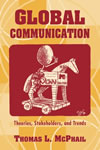 |
 |
 |
 |
![]()
Volume 6,
Issue 1,
Fall 2002
|
Global Communication: Theories, Stakeholders, and Trends McPhail, Thomas L.Allyn & Bacon, 2002 272 pages Paper: US $49.00 |

|
Reviewed by: Lizie,
Arthur, Bridgewater State College
Printer-friendly PDF
version
Thomas L. McPhail’s Global Communication: Theories, Stakeholders, and Trends offers a valuable primer on the core ideas, burning issues, and key players involved in the perpetually-in-flux world of international media ownership and media-globalization theory. As such, it can serve as an excellent entry-level textbook for upper-level undergraduate and beginning graduate students, or as a refresher volume for journalists and policymakers. However, this endorsement arrives quite partially and with a strong caveat, just as any book would that defends its theoretical propensities with a sentence declaring that it “does not promote any particular philosophical or ideological school, whether of the Left or the Right.” On its surface, this remark is the intellectual equivalent of a used car dealer cornering you on the lot and telling you she doesn’t care if you buy a car, she just wants to make sure you know your options. At its core, this neutrality declaration belies an aggressive subtext throughout Global Communication that disparages the “shrill rhetoric of concern and protest” and “stale” ideas of critical-media approaches while championing free-market and Western-oriented approaches to international communication theory. his strand of alleged neutrality is perhaps nowhere more evident than in the recounting of the protracted UNESCO/NWICO media-sovereignty struggles between Western and Non-Aligned nations of the 1970s and 1980s, a series of events backhandedly praised here for its ultimate “reaffirmation of values.” (Guess whose values were reaffirmed?)
In spite of this bent, the book performs a necessary and useful function by collecting and contextualizing multiple historical and current strands of the international communication field that are often wholly neglected, passed over quickly in a paragraph or two, or found only in disparate resources. The main strength of this broad approach is to further dispel the myth that international Western entertainment, news, and advertising media are a monolithic, conspiratorial beast (save in their pursuit of capital and content). The two chapters on the five current U.S. media colossals (AOL Time Warner, Viacom, Disney, GE, and AT&T) and the major non-U.S. stakeholders (including Bertelsmann, Vivendi, Universal, and Sony) provide clear, historically based outlines of both the internal synergies and unique external positioning strategies of these communication-cum- information-cum-entertainment giants. Chapters on global advertising, CNN and its international rivals, and wire services accomplish the same tasks with illuminating breadth and depth. If you need to learn the who/what/when/where of global communication, these chapters are a decent place to start your education.
Beyond this descriptive level, the book does not achieve its stated goal. The proposed theoretical goal of the text is to forge a new framework for understanding global communication by combining World Systems Theory (WST) with McPhail’s Electronic Colonialism Theory (ECT). WST is a functional model of the global flow of information, goods, and services from core nations (e.g., US, EU, Japan) to semi-peripheral (e.g., Mexico, China, Brazil) and peripheral (e.g., most of Africa, Latin America, Asia) nations. ECT is the idea that the flow of cultural products from one (developed) country to another (underdeveloped) country can influence and possibly destroy indigenous traditions of the receiving culture. Unfortunately, this third-way theoretical framework fails to materialize. Instead, McPhail offers a top-heavy rendering of a communication system, one so involved in describing the process of the flow of information that the products and consequences – the cultural effects – are virtually ignored. What happens to real people in this explanation of global communication? This is never answered as the utility and workings of this new theoretical combination are not clearly defined, illustrated, or even named.
Global Communication leaves the reader with the now-standard call for more empirical and less ideologically driven research and an optimistic, trickledown capitalist model of international communication – a mixture of dependency theory without the troublesome specter of second-world influence, and cultural imperialism theory without the moral outrage. This approach braces the already empowered at the expense of the disenfranchised, offering another unwound reel of the dark globalization comedy Dr. Status Quo, or How I Learned to Stop Worrying and Love the Global.
Back to Top
Home | Current
Issue | Archives | Editorial
Information | Search | Interact